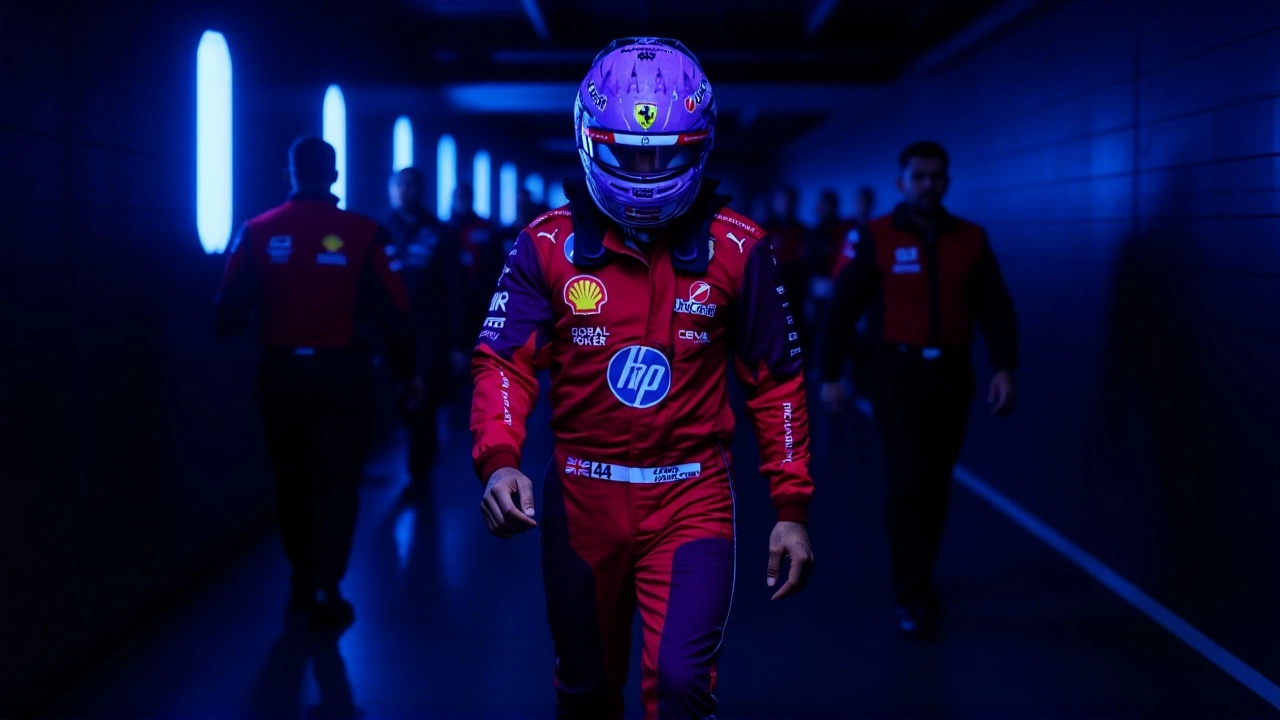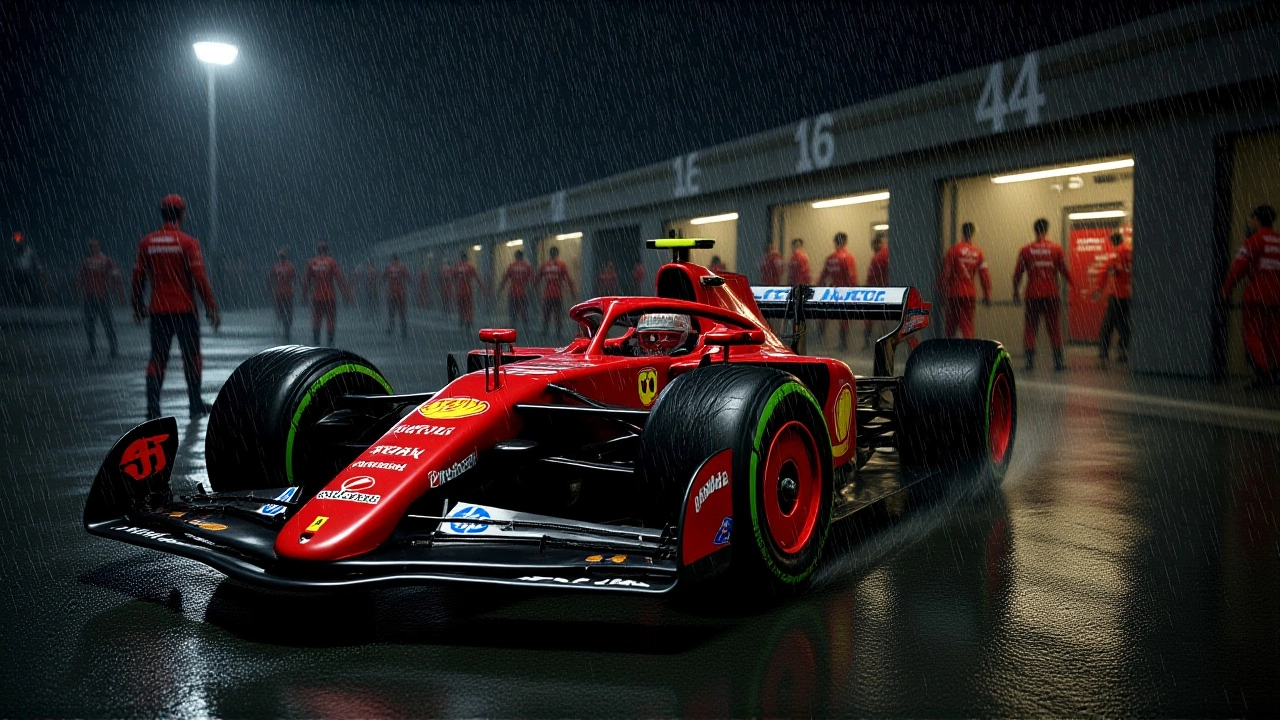On November 23, 2025, Lewis Hamilton, the seven-time Formula 1 World Champion, faced his most humbling moment in 17 seasons of racing — eliminated in Q1 at the Las Vegas Grand PrixLas Vegas Strip Circuit — not by a crash, not by a penalty, but because his Scuderia Ferrari car simply wouldn’t work in the cold, wet conditions. Hamilton, 40, qualified a shocking 20th — last — nearly three seconds slower than teammate Charles Leclerc, who made it into Q2. The difference wasn’t luck. It was a chassis failure. And Hamilton said it best: “I couldn’t get the tires to work.” Not wouldn’t. Not didn’t. Couldn’t. That word, spoken in the quiet of the garage, echoed louder than any engine roar.
The Cold Truth Behind the Tire Failure
Asphalt temperatures at the Las Vegas Strip Circuit dipped to 10°C during qualifying — colder than any race weekend this season. For most teams, it was a challenge. For Ferrari, it was a catastrophe. The SF-25, designed to thrive in high-temperature circuits like Spa and Monza, completely lost its aerodynamic balance in the damp, chilly conditions. Tire temperatures never reached their optimal window. Hamilton’s front left, in particular, never heated past 55°C — well below the 75°C threshold needed for grip. Technical analysts from Crash.net and Sky Sports confirmed: Ferrari’s front wing and underbody airflow design couldn’t generate enough heat transfer to the Pirelli Cinturato intermediates. It wasn’t driver error. It was engineering blind spots.
A Miscommunication That Cost a Lap
What made it worse was the radio exchange between Hamilton and his Italian race engineer, Riccardo Adami. With 17 seconds left on the clock, Hamilton radioed: “Are we safe?” Adami replied: “Keep pushing.” Hamilton then said: “I got the light...” — referring to the red light at the finish line that signals the end of a session. But timing data showed he crossed the timing point 0.4 seconds before the clock hit zero. The red light, triggered by the circuit’s automated system, didn’t illuminate until half a second after he passed the line — and only then, at the start line, where a second timing point exists. Hamilton, confused by the dual lines and poor visibility in the rain, believed he’d missed his chance. He lifted off. Adami’s reply — “No, push!” — came too late. As David Croft, Sky Sports’ technical analyst, put it: “Once a driver lifts off, the lap’s gone. Telling him to push again is like telling a falling man to jump higher.”
The Cone That Changed Everything
Most viewers missed it. But the telemetry showed Hamilton clipped a cone on the exit of Turn 11 — a minor tap, barely visible on the broadcast. In dry conditions, it’s a nothing. In wet, cold asphalt? It was a disaster. The contact disrupted the car’s aerodynamic balance, throwing off tire temperatures further. By the time he reached the final sector, the front tires were already cold. The lap was dead on arrival. Hamilton later told reporters: “After FP3, I felt we had good pace. But the wet conditions didn’t work in our favor.” He cited yellow flags and poor visibility. But the truth? The car was fundamentally broken in low-temperature wet conditions — a flaw that’s haunted him all season.

A Season of Disappointment
This wasn’t an isolated incident. Hamilton’s first season with Ferrari has been a slow unraveling. He retired from the Sao Paulo Grand PrixInterlagos after a hydraulic failure. He finished outside the top five in seven of the last nine races. Ferrari dropped from second to fourth in the constructors’ standings after Brazil. And now, in Las Vegas, he’s the only driver in F1 history to be eliminated in Q1 purely on pace — no penalty, no crash, no red flag — without making it past the first session in 17 years.
Elkann’s Warning and the Team’s Tension
John Elkann, Chairman of Ferrari N.V., didn’t mince words after the race: “It’s important that our drivers focus on driving and talk less.” The comment, made to Italian media, was clearly aimed at Hamilton, who has been unusually vocal about the car’s shortcomings — a stark contrast to his reserved Mercedes days. Leclerc, meanwhile, has quietly outperformed him in every metric this season: qualifying positions, race pace, tire management. The internal tension is palpable. Sources close to the team say engineers are frustrated by what they see as Hamilton’s reluctance to adapt his driving style to the SF-25’s unique characteristics — particularly its sensitivity to rear tire degradation.

What’s Next: Qatar and Abu Dhabi
With only two races left — the Qatar Grand PrixLusail International Circuit on November 29, and the season finale in Abu Dhabi on December 6 — Hamilton’s chances of salvaging his Ferrari debut are fading. The Qatar circuit is expected to be hotter, which might help the SF-25. But Abu Dhabi’s night race on a smooth, high-grip surface? That’s where Ferrari’s weaknesses could be exposed again. Hamilton finished eighth in Las Vegas after starting 19th, thanks to disqualifications of Yuki Tsunoda, Oscar Piastri, and Lando Norris. But points aren’t the issue anymore. It’s dignity. It’s legacy. And for the first time, Hamilton looks like a driver fighting not just for position — but for relevance.
Why This Matters Beyond the Track
This isn’t just about one driver’s bad day. It’s about the fragility of legacy. Hamilton, who once dominated F1 with Mercedes, now drives for the most storied team in the sport — and it’s failing him. His performance in Las Vegas has reignited debates: Was the move to Ferrari a gamble worth taking? Or a career misstep? For Ferrari, it’s a warning. If their 2026 car doesn’t solve the cold-weather tire issue, they risk losing Hamilton — and the credibility that comes with signing the most decorated driver in history. And for fans? It’s a reminder that even legends can be exposed by bad engineering.
Frequently Asked Questions
Why couldn’t Hamilton get the tires to work in Las Vegas?
The SF-25’s aerodynamic design generates insufficient heat transfer to the tires in low-temperature, wet conditions. At 10°C asphalt, the front tires never reached the 75°C operating window needed for grip. Ferrari’s front wing and underbody airflow couldn’t create the necessary vortexes to warm the tires — a flaw exposed in every cold-weather session this season, from Spa to Las Vegas.
Was Hamilton’s radio communication with Adami the main cause of his poor lap?
No — the miscommunication was a symptom, not the root cause. Timing data confirmed Hamilton had time for another lap. But the car’s lack of grip meant even if he’d pushed harder, he couldn’t have improved his time. The radio exchange only highlights how disconnected the team was from the car’s actual performance limits — a deeper issue than one misunderstood instruction.
How does this compare to Hamilton’s past qualifying failures?
In his 17-year career, Hamilton had never been eliminated in Q1 without a penalty, crash, or red flag. His worst previous qualifying was 11th at the 2020 Eifel Grand Prix — still 10 positions ahead of this result. This is the first time his pace alone, without external factors, has failed to get him out of the first session — a historic low for a driver with 103 pole positions.
Is Ferrari’s SF-25 fundamentally flawed?
Yes — multiple F1 insiders confirm the SF-25 is optimized for high-temperature, high-downforce tracks but fails catastrophically below 15°C. The car’s rear-end instability and front-end understeer are worse in damp conditions. Technical teams from Red Bull and Mercedes have privately noted the SF-25’s airflow is too dependent on heat generation — a design flaw that could cost Ferrari the 2026 championship if not corrected.
What does John Elkann’s comment mean for Hamilton’s future at Ferrari?
It signals a power shift. Elkann’s remark — telling drivers to “talk less” — is a direct rebuke of Hamilton’s public criticism of the car. If Hamilton continues to voice concerns, Ferrari may quietly begin preparing for his exit after 2025. His contract runs through 2027, but internal trust is eroding. He may be the last driver to leave Ferrari under a cloud of performance disappointment.
Can Hamilton still salvage his 2025 season?
Statistically, yes — but realistically, no. He’s 40 points behind Leclerc in the drivers’ standings with only 52 points left available. Even if he wins both remaining races and Leclerc scores nothing, Hamilton would still finish second — but only if Ferrari fixes the SF-25’s tire issues. Given the team’s lack of development progress this season, that’s unlikely. His legacy won’t be defined by 2025 — but by how he responds to it.

